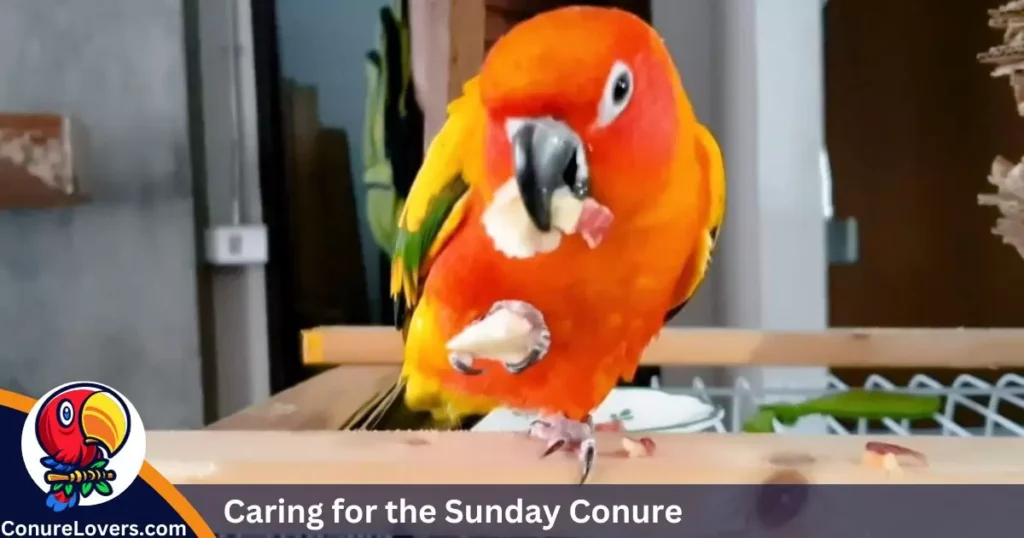Meet the Sunday Conure – a cool combo of the popular Sun Conure and Jenday Conure! The name Sunday comes from blending sun from sun conures and day from Jendays.
These hybrids rock a stunning mix of colors inherited from both sun and Jenday conures. Both types belong to the Aratinga family, looking similar in size and appearance.
The main difference? Wing color! Jenday conures sport green wings, while sun conures flaunt yellow. Now, imagine the Sunday conure – its wings are a cool combo of green and yellow, with green covering about 60-70% of the wing space.
Beyond their fabulous feathers, Sunday conures are super chill, playful, full of energy, and downright enchanting. Perfect as pets, they can hang around for 25-30 years. Oh, and fun fact – you can only snag a Sunday conure in captivity. Keep their diet similar to sun conures, and you’re good to go!
Origin and History
From Venezuela to Guyana, the Sun Conure calls the northeastern part of South America home. These vibrant birds thrive in tropical inland habitats, but you can also spot them in coastal rainforests and dry savanna woodlands.
They particularly fancy chilling in palm groves and fruiting trees. Now, let’s talk about their cousins, the Jenday Conures, native to the woodlands, palm groves, and dense vegetation of northeastern Brazil. They usually travel in small flocks, capping at around 30 birds, and make nests in hollow trees.
Because both Jenday and Sun Conures belong to the Aratinga family, they can actually mate with each other. However, don’t expect this in the wild since their natural habitats don’t quite overlap. But, some parrot breeders make it happen, creating a stunning hybrid known as the Sunday Conure.
Unlike the common belief that hybrid parrots are sterile, Sunday Conures defy that. They’re fertile and perfectly capable of having little conure babies. In fact, breeders have even crossed Sunday Conures with Sun Conures to create a second-generation hybrid. There’s also the mix of Sun Conures with Nonday Conures, resulting in the unique nansun conure.
When it comes to size, Sunday Conures are like Sun Conures, measuring around 12 inches long, including the tail, and weighing between 100 and 120 grams. Their wings showcase a cool combo of green (70%) and yellow (30%).
In the Jenday conure vs Sun conure showdown, the key difference lies in their wing colors. Jendays rock green wings, while Suns flaunt yellow. Other features, like the black beak, white eye rings, and that chic long tail, are pretty much the same.
Spotting a juvenile conure? Good luck telling Sunday, Sun, and Jenday apart since they all sport green wings. It’s only when they hit 9-8 months and molt for the first time that their true colors emerge. By the time they’re two, these parrots are ready to show off their full, vibrant hues.
Personality
| Personality Traits | Jenday Conure | Sun Conure |
| Athletic Tricks | Enjoys | Enjoys |
| Playful & Amusing | Yes | Yes |
| Trainability | Easy | Easy |
| Interaction | Intelligent, Interactive, Willing to Learn | Intelligent, Interactive, Willing to Learn |
| Family Pet Qualities | Excellent due to lovable and affectionate nature | Excellent due to lovable and affectionate nature |
| Aggressiveness | May become aggressive when provoked | May become aggressive when provoked |
| Nippy Behavior | Can exhibit nippy behavior at times | Can exhibit nippy behavior at times |
| Human Interaction | Requires significant human interaction | Requires significant human interaction |
| Response to Startle | May bite as a natural response | May bite as a natural response |
Speech and Sound
Even though Sunday conures aren’t the loudest in the conure squad, don’t be fooled – they can still belt out some serious screams, regardless of their volume. Most conures are pretty famous for their vocal antics, so it’s crucial not to roll the dice and end up with a bird that’s not exactly a mute.
While Sundays don’t exactly turn your home into a constant concert hall, they’re not shy about letting out some sharp and piercing calls. Typically, they mix it up, going from loud moments to hushing down. But here’s the catch: when these little guys feel insecure or lonely, they might crank up the noise for what feels like forever – and trust me, it can get irritating.
Now, as far as chatter goes, Sundays aren’t record-breakers in the talking department. They might not host a full conversation, but they can definitely pick up a few words here and there. So, if you’re cool with a bit of noise and maybe a word or two, a Sunday conure might just be your feathery friend.
Read Also: Can Green Cheek Conures Eat Grapes
Caring for the Sunday Conure

Sunday conures are energetic beings, so they need a roomy pad to call home. Picture this: a cage that’s at least 20 inches by 20 inches, standing tall at a minimum of 36 inches. And here’s the deal-breaker – make sure the bars are slim, around 3/4 inches wide. Why? Because these little escapists have a knack for trying to break free, and sometimes, they end up with their heads stuck in the bars.
But life for Sunday conures isn’t just confined to the cage. Oh no, they love to explore and check out new spots beyond their cozy enclosure. They’re big fans of climbing and playing on a gym, giving those legs and wings a good stretch. Warning: if they don’t get this playtime opportunity, they might unleash their inner wrecking crew.
Now, here’s the thing about these conures – they need a bit of schooling, but they’re not too keen on getting scolded. Socialization is key to teach them how to mingle with others the right way. So, if you’re up for the challenge and want a lively companion, a Sunday conure might just be your feathered sidekick!
Sunday Conure Lifespan

The wild lifespan of Sun Conures and Jenday Conures isn’t precisely documented. However, when it comes to living the good life in captivity, both these conures – Sun and Jenday – can stick around for a solid 20 to 25 years. Now, let’s talk about their hybrid cousin, the Sunday conure. In the cozy setting of captivity, Sundays take the cake with an impressive lifespan of 25-30 years. So, if you’re looking for a long-term feathery friend, these conures have got the clock ticking in their favor.
Concerns Regarding Sun Conure Hybridization

Hybridization is not the norm for these genus members, mainly because the two species stick to their own turf and don’t typically run into each other. Adding to the mix, conures are also the monogamous type.
When it comes to Sun Conures, those cozying up with their own kind don’t bat an eye at Jendays. It’s a hiccup commonly faced by pet lovers and traders. The ones you’re likely to bump into are the captive-bred Sun Conures.
Now, here’s the kicker – the conservation status puts a legal leash on trading these birds as pets. If you’re on the lookout, brace yourself for some hefty price tags, often reaching into four figures.
Some breeders take a walk on the wild side, mixing parrots to create eye-catching colors and fetch those high prices, just like the sought-after Sunday Conure. But, there’s a snag – too much mixing could water down the species, posing a threat.
And here’s the twist – scientists worry about monogamy in this whole hybrid dance. Captive Sun Conures that hitch up with Jendays might miss out on mingling with their fellow Conures down the road. This loss of potential breeding pairs makes conservation efforts a tougher nut to crack.

Matthew Porter here, your Conure Care Companion at “Conure Lovers.” Together, let’s build a harmonious and joyful space for your feathered friend. I’m here to make conure care easy and enjoyable!












